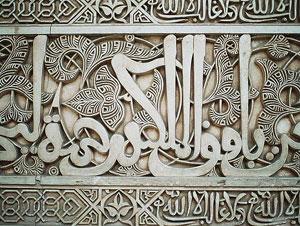De-coding the Alhambra
Detail of inner Alhambra wall (image: CC by roel /Flickr)
There’s a painstaking mapping process underway now in Spain. We’re not talking about a geographic map. What Spanish investigators are trying to catalogue are thousands of Arabic inscriptions that cover the walls and the columns of the Alhambra. The Alhambra was a Moorish fort. It was the last one to fall during the Spanish reconquest in the 15th century. And those inscriptions could shed more light on the palace’s history. The World’s Gerry Hadden reports from Granada.
GERRY HADDEN: Thousands of tourists file through the Alhambra’s gardens and courtyards on a recent morning. Visitors here admire the architecture, the decorative fountains, the tiled arches, the ornate plaster moulds but one man in the crowd, Juan Castilla, is focused on something the untrained eye often misses. The entire complex is literally covered in words.
JUAN CASTILLA: [SPEAKING SPANISH]
HADDEN PARAPHRASING: Castilla says when you stroll through the Alhambra reading its inscriptions it’s like leafing through a volume of beautiful poems. In that sense he says it’s unique.
HADDEN: Castilla is heading a project to locate and transcribe the more than 10,000 inscriptions here. They’re all in classical Arabic and most were commissioned during the reins of the last Moorish kings in Spain in the 14th and 15th centuries. They’re a mixture of poems, proverbs, remembrances, and verse from Koran. They’re chiseled into nearly every wall, column, fountain, and doorway and they tell stories of sorts. First and foremost the story of Muslim devotion. Most of the inscriptions are simple declarations – thanks to God for example or God is great. Other texts are more elaborate. Castilla reads allowed a poem inscribed around a shelf once used to hold vases of water at the entrance to a prayer room. The poem compares a vase being poured to the inclined posture of a kneeling worshipper.
CASTILLA: [SPEAING SPANISHI]
TRANSLATOR: As you approach me consider this. The pouring vase whispers like the faithful devotee praying within. Each time he’s emptied he must start anew.
HADDEN: There are also short histories – a victory in battle over the Christians at Algeciras. The circumcision of the son of King Mohammad the 5th. Other inscriptions are odes to beauty. One poem is in the first person. Its white flowing letters form a circle. Although it’s etched in simple plaster the verse appear to shine like alabaster in the soft light from surrounding open arches. The poem itself speaks of the exquisite workmanship.
CASTILLA: [SPEAKING SPANISH]
TRANSLATOR: The arts have offered me their beauty. Given me perfection and splendor. He who looks upon me is the deceived by his eyes and thoughts for I am so translucent that even the moon sits happily upon me like a halo.
HADDEN: Castilla says such poems help researchers today understand the appreciation of beauty in Moorish Spain. It’s become a labor of love. Castilla has been working on this literary map now for seven years. But he says the writings have fascinated the Spanish since the Catholic Kings Ferdinand and Isabella took the Alhambra in 1492. That marked the end of Al Andalus the Moorish kingdom in Spain. The Christian monarchs were so impressed with the inscriptions that they set up a special school of translators to do exactly what Castilla is doing now. But they failed Castilla says as have many others since.
CASTILLA: [SPEAKING SPANISH]
HADDEN PARAPHRASING: He says the cataloguing has never been finished because each researcher would get sidetracked, drawn into investigating some small detail or verse for a year or two, then they’d return to the cataloguing only to get sidetracked again. Eventually, he says, they’d fall off the tracks all together. Castilla is confident that this time things will be different. He and his team predict they’ll be finished within three years. They have it a bit easier than their forbearers. They’re using modern equipment. Hydraulic lists give them access to the most remote inscriptions hidden high up in the ceilings. Remote controlled high resolution cameras help them decipher the most deteriorated pieces of writing.
CASTILLA: [SPEAKING SPANISH]
HADDEN PARAPHRASING: Whatever happens after we’re finished Castilla says, if the walls crumble and deteriorate, we’ll have this map forever. This will be our legacy.
PRI’s "The World" is a one-hour, weekday radio news magazine offering a mix of news, features, interviews, and music from around the globe. "The World" is a co-production of the BBC World Service, PRI and WGBH Boston.
The story you just read is not locked behind a paywall because listeners and readers like you generously support our nonprofit newsroom. If you’ve been thinking about making a donation, this is the best time to do it. Your support will get our fundraiser off to a solid start and help keep our newsroom on strong footing. If you believe in our work, will you give today? We need your help now more than ever!
